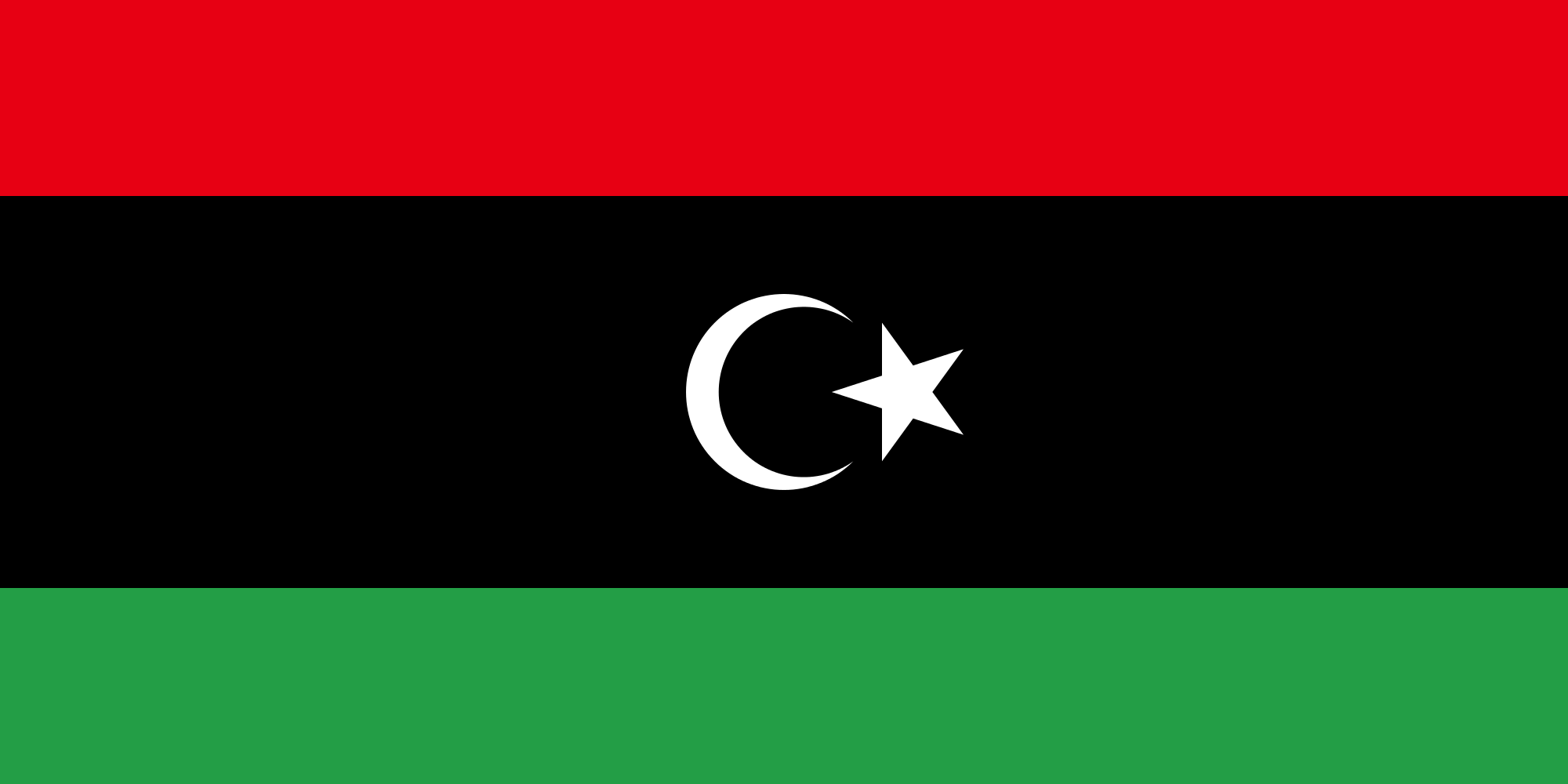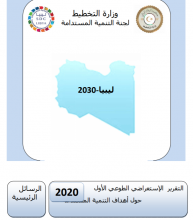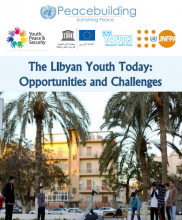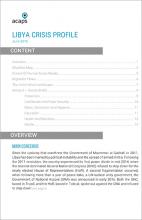 Libya
Libya
With an area of around 1.76 million km2[1], Libya is the third largest Arab country in Africa. The Libyan population is mostly urban, with around 81.3 percent of the population of 6.7 million live in urban areas in 2022.[2][3] Political instability and conflict are changing Libya’s age structure: the percentage of people under the age of 24 fell to 46.1 percent in 2022, down from 48.3 percent in 2010. [2] Life expectancy at birth reached 72.2 years [2], slightly higher than the regional average of 70.8 years[4], and total fertility rate has reached 2.4 children per woman in 2022.[2]
Libya’s HDI value for 2018 is 0.718— which puts the country in the lower range of the high human development category— positioning it at 104 out of 191 countries and territories. The country’s value is below the average of 0.754 for countries in the high human development group and above the average of 0.708 for countries in Arab States.[5]
Libya returned to a state of violent conflict and political turmoil in April 2019, affecting the economic performance and exacerbating the already existing humanitarian hardships faced by the population.[6] It remains in a political stalemate with competing centers of power claiming legitimacy for control of the country.[6]
Libya is a major transit route for migrants crossing to Europe from Africa.[8] According to UNOCHA, an estimated 823,000 people in Libya, including 248,000 children, require humanitarian assistance due to ongoing political instability, conflict, and a deteriorating economy. This includes internally displaced persons, returnees, conflict-affected individuals, host communities, refugees and migrants.[9] This was exacerbated by a devastating natural disaster that unfolded in eastern Libya (Storm Daniel on the 10th of September). In addition to its effect, a catastrophic event occurred when two dams upstream of the coastal city of Derna, situated on the Wadi Darnah River, tragically failed. The flooding destroyed entire neighborhoods, death of more than 4000 people and more than 10000 unaccounted for, and more than 3400 displaced persons.[6]
The destruction of civilian infrastructure like schools and hospitals made access to basic services such as education, health services, safe water, and sanitation limited. According to the UNICEF 2022 Humanitarian Needs Overview (HNO), in 2021 nearly 160,000 children and 5,600 teachers were estimated to need education assistance. Moreover, as of February 2021, health facilities were not all fully operational in Libya. Private health centers were mostly in operation (70 percent), while less than half of public health centers were completely operational. Only 54 percent of hospitals were entirely working and provided the full range of services.[7] According to UNICEF Humanitarian Action for Children 2023, nearly 247,400 people lack access to safe water, sanitation, and hygiene services; more than 175,800 children require immediate protection; and nearly 111,400 children will lose access to learning opportunities without humanitarian assistance.
Despite having the fifth largest oil reserves (after Saudi Arabia, Iraq, United Arab Emirates, and Kuwait ) in the Arab region[10] where revenues from the hydrocarbon sector represented 60 percent of GDP,[11] around a third of the population live in poverty.[12] Following a deep recession over 2013-16, driven by a steep decline in oil production from 70 million ton oil equivalent (Mtoe) in 2012 to 18.2 Mtoe in 2016, largely due to political instability and conflict, the Libyan economy was able to substantially increase oil production to 42.3 Mtoe in 2017,[13] driving real GDP to grow by 64 percent in 2017. However, the annual average GDP growth rate took a sharp decline in 2019 and 2020, reaching -11.2 percent and -29.4 percent, respectively.in 2021, it increased 28.3 percent and then it dropped to -9.62 percent in 2022.[14]
Fluctuating oil revenues and inflexibility in the government expenditures resulted in the country’s overall fiscal situation being under severe stress during the period 2013-2018. However, in 2019, due to higher revenues, at 57,365.2 million Libyan Dinar (LYD) in the fourth quarter of 2019 compared to 35,911.2 million LYD in the fourth quarter of 2018 [15], Libya’s net lending/ borrowing ran into surplus at 9.3 percent of GDP in 2018 after five years of deficits. In 2020, it dropped to -22.2 and then it increased to 14.8 and 23.1 percent in 2021 and 2022 respectively. In 2020 and 2021, the current account registered a deficit at -8.4 and -5.3 percent of GDP, after recording surpluses for three years in a row. However, in 2022, it increased to register 32.8 percent of GDP. [14]
After three years of high inflation in Libya over 2015-2017, the consumer price index (CPI) registered a negative value in 2018, averaging around -1.2, and increased progressively registering 4.1 in 2022.[14]
Unemployment remained relatively stable in the range of 20 percent between 2000 and 2022 registering 20.68 percent. However, youth remain the most affected with almost 70.1 percent of females between the age of 15-24 are unemployed, compared to 43 percent of males in 2022, according to ILO modeled estimates.[16]
This overview was last updated in November 2023. Priority is given to the latest available official data published by national statistical offices and/or public institutions.
Sources:
[1] Food and Agriculture Organization of the United Nations (FAO). 2016. AQUASTAT Main Database [ONLINE] Available at: http://www.fao.org/nr/water/aquastat/data/query/index.html?lang=en [Accessed 23 April 2020].
[2] Population Division of the Department of Economic and Social Affairs of the United Nations Secretariat. 2023. World Population Prospects. [ONLINE] Available at:
https://population.un.org/wpp/Download/Standard/Population/ [Accessed 23 October 2023].
[3] Population Division of the Department of Economic and Social Affairs of the United Nations Secretariat. 2023. World Urbanization Prospects. [ONLINE] Available at:
https://population.un.org/wup/ [Accessed 23 October 2023].
[4] The World Bank. 2023. World Development Indicators. [ONLINE] Available at: https://databank.worldbank.org/source/world-development-indicators [Accessed 23 August 2023].
[5] United Nations Development Programme (UNDP). 2023. Human Development Index. [ONLINE] Available at: https://hdr.undp.org/data-center/documentation-and-downloads; https://hdr.undp.org/data-center/country-insights#/ranks [Accessed 25 October 2023].
[6] The World Bank. 2023. Libya Overview. [ONLINE] Available at: http://www.worldbank.org/en/country/libya/overview [Accessed 10 November 2023].
[7] Statista. 2023. Availability of health services in Libya 2021, by facility [ONLINE] Available at: https://www.statista.com/statistics/1222503/availability-of-health-services-in-libya-by-facility/#:~:text=As%20of%20February%202021%2C%20health,the%20full%20range%20of%20services. [Accessed 10 November 2023].
[8] United Nations High Commissioner for Refugees (UNHCR). 2020. Operational Portal Refugee Situation: Libya. [ONLINE] Available at:
https://data2.unhcr.org/en/country/lby [Accessed 23 April 2020].
[9] ] United Nations Office for the Coordination of Humanitarian Affairs (UNOCHA). 2023. overview Libya. [ONLINE] Available at: https://www.unocha.org/libya#:~:text=In%20Libya%2C%20an%20estimated%20823%2C000,conflict%20and%20a%20deteriorating%20economy [Accessed 10 November 2023].
[10] Organization of Petroleum Exporting Countries (OPEC). 2023. OPEC Share of World Crude Oil Reserves. [ONLINE] Available at: https://www.opec.org/opec_web/en/data_graphs/330.htm#:~:text=According%20to%20current%20estimates%2C%2080.4,67.1%25%20of%20the%20OPEC%20total. [Accessed 10 November 2023].
[11] World bank. April 2020. Libya Economic Update. [ONLINE] Available at: http://pubdocs.worldbank.org/en/952021554825498099/mpo-lby.pdf [Accessed 1 June 2020].
[12] Armitage, J. July 2018. Libya sinks into poverty as the oil money disappears into foreign bank accounts. The Independent. [ONLINE] Available at:
https://www.independent.co.uk/news/business/analysis-and-features/libya-poverty-corruption-a8451826.html [Accessed 1 June 2020].
[13] International Energy Agency. 2020. Data and Statistics [ONLINE]Available at: https://www.iea.org/data-and-statistics?country=LIBYA&fuel=Oil&indicator=Oil%20production [Accessed 1 June 2020].
[14] International Monetary Fund. 2023. World Economic Outlook Database [ONLINE] Available at:
https://www.imf.org/en/Publications/SPROLLs/world-economic-outlook-databases#sort=%40imfdate%20descending [Accessed 24 October 2023].
[15] Central Bank of Libya. 2019. Economic Bulletin. [ONLINE] Available at: https://cbl.gov.ly/en/economic-bulletin/ [Accessed 1 June 2020].
[16] International Labour Organization (ILO). 2023. [ONLINE] Available at: https://ilostat.ilo.org/data/ [Accessed 23 September 2023].
Data Highlights
-
In Libya, like other Arab countries, it is the women who are severely affected by unemployment. Youth women's unemployment rate registered 70.1 percent in 2022




